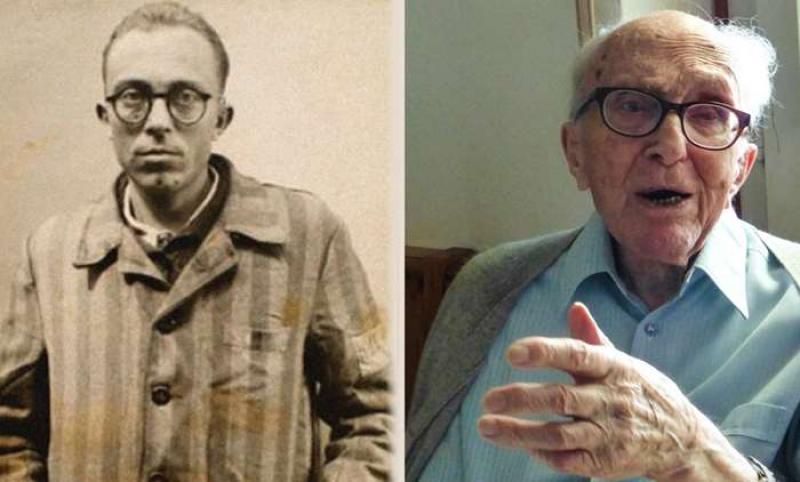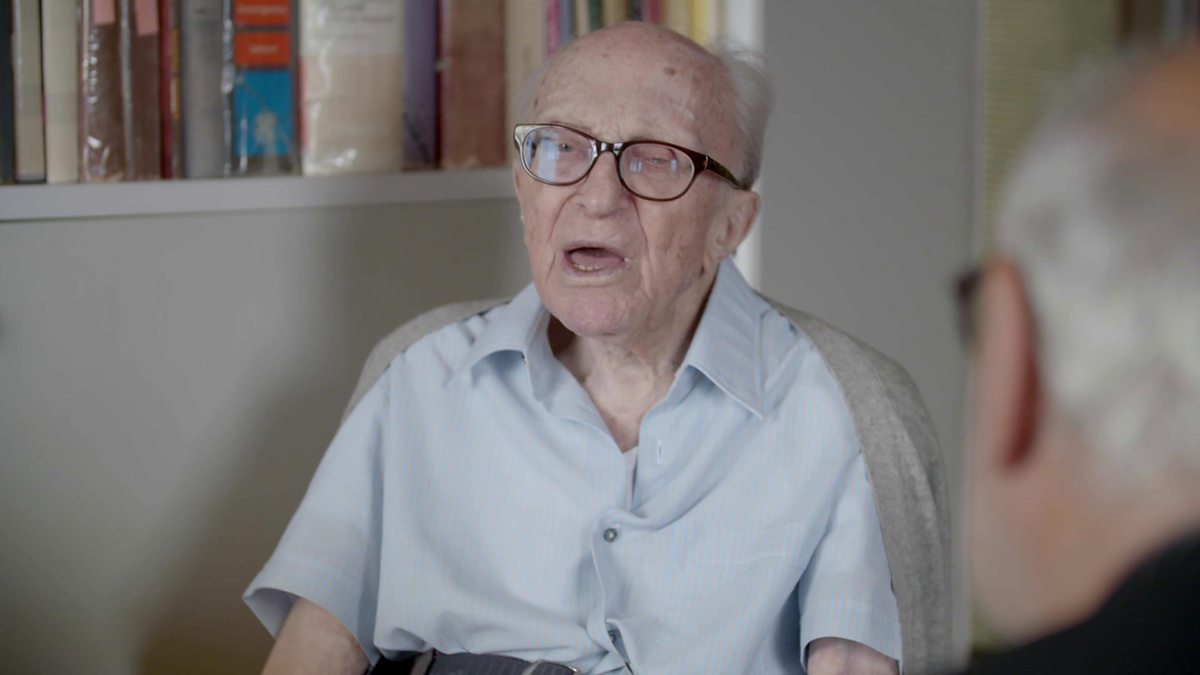The Man Who Saw Too Much, BBC One review – death camp in the clouds | reviews, news & interviews
The Man Who Saw Too Much, BBC One review – death camp in the clouds
The Man Who Saw Too Much, BBC One review – death camp in the clouds
Holocaust survivor documents his experiences as a prisoner and salvaged writer

Boris Pahor is the oldest known survivor of the Nazi concentration camps. In this program, the 106-year-old recounts his experiences as a political refugee and prisoner to the Nazis during their rule in his native Slovenia.
Pahor was captive at the Natzweiler camp, which was a comparatively small concentration camp located in the Vosges mountains in Alsace. Its site was chosen because of its proximity to a granite quarry which contained the kind of pink-coloured stone that Hitler preferred for his palatial interiors. The site was also converted from a luxury ski resort, emblematic of the cruel fate-twists the Nazis were capable of engineering. To Pahor it resembled “a doomed Mexican ruin”, referring to the tiered steps that ran up the steep hill of the camp. Pahor and other inmates were forced to trek up and down, often carrying heaving sacks of stone. When Pahor returns to the camp as part of this program, he shudders at the large tourist groups, shocked by their indifference as well as the image they resemble.
 Through spoken readings from Pahor’s published writing, we are given an extremely close insight to his experiences. Natzweiler was a small camp in comparison with the mechanised extermination camps of Auschwitz and Sobibor. As a result, prisoners were involved much more directly in the killing machine. Pahor recounts the use of specially designed pliers, which clamped around the necks of bodies to allow their easy removal from gas chambers. The prisoners were forced to drag the emaciated bodies of their fellow inmates from chamber to burner. “It would be interesting to get to know the man who designed those pliers”, Pahor says, with the trademark understatement, or numbness, that flows through his style.
Through spoken readings from Pahor’s published writing, we are given an extremely close insight to his experiences. Natzweiler was a small camp in comparison with the mechanised extermination camps of Auschwitz and Sobibor. As a result, prisoners were involved much more directly in the killing machine. Pahor recounts the use of specially designed pliers, which clamped around the necks of bodies to allow their easy removal from gas chambers. The prisoners were forced to drag the emaciated bodies of their fellow inmates from chamber to burner. “It would be interesting to get to know the man who designed those pliers”, Pahor says, with the trademark understatement, or numbness, that flows through his style.
This program is as much the study of a writer as it is of a prisoner. In the autobiographical book Necropolis, published in 1967, Pahor documents his life during the war. His prose is unembellished and graceful, the soft record of an experience of memory and the warped aesthetic of horror. In his present home overlooking the Gulf of Trieste, Pahor sits next to his Remington typewriter beneath shelves of books. Writing, he suggests, affords no consolation but it does offer understanding. For us, his writing is both evidence and moving art.
The tapered and focused view taken in The Man Who Saw Too Much is a rewarding shift from the more bombastic, broad-view Holocaust documentaries that tend to dominate the TV market. It is about one man and the nuanced way that he turned a way of remembering into a way of seeing, and writing.
The future of Arts Journalism
You can stop theartsdesk.com closing!
We urgently need financing to survive. Our fundraising drive has thus far raised £49,000 but we need to reach £100,000 or we will be forced to close. Please contribute here: https://gofund.me/c3f6033d
And if you can forward this information to anyone who might assist, we’d be grateful.

Subscribe to theartsdesk.com
Thank you for continuing to read our work on theartsdesk.com. For unlimited access to every article in its entirety, including our archive of more than 15,000 pieces, we're asking for £5 per month or £40 per year. We feel it's a very good deal, and hope you do too.
To take a subscription now simply click here.
And if you're looking for that extra gift for a friend or family member, why not treat them to a theartsdesk.com gift subscription?
more TV
 Murder Before Evensong, Acorn TV review - death comes to the picturesque village of Champton
The Rev Richard Coles's sleuthing cleric hits the screen
Murder Before Evensong, Acorn TV review - death comes to the picturesque village of Champton
The Rev Richard Coles's sleuthing cleric hits the screen
 Black Rabbit, Netflix review - grime and punishment in New York City
Jude Law and Jason Bateman tread the thin line between love and hate
Black Rabbit, Netflix review - grime and punishment in New York City
Jude Law and Jason Bateman tread the thin line between love and hate
 The Hack, ITV review - plodding anatomy of twin UK scandals
Jack Thorne's skill can't disguise the bagginess of his double-headed material
The Hack, ITV review - plodding anatomy of twin UK scandals
Jack Thorne's skill can't disguise the bagginess of his double-headed material
 Slow Horses, Series 5, Apple TV+ review - terror, trauma and impeccable comic timing
Jackson Lamb's band of MI5 misfits continues to fascinate and amuse
Slow Horses, Series 5, Apple TV+ review - terror, trauma and impeccable comic timing
Jackson Lamb's band of MI5 misfits continues to fascinate and amuse
 Coldwater, ITV1 review - horror and black comedy in the Highlands
Superb cast lights up David Ireland's cunning thriller
Coldwater, ITV1 review - horror and black comedy in the Highlands
Superb cast lights up David Ireland's cunning thriller
 Blu-ray: The Sweeney - Series One
Influential and entertaining 1970s police drama, handsomely restored
Blu-ray: The Sweeney - Series One
Influential and entertaining 1970s police drama, handsomely restored
 I Fought the Law, ITVX review - how an 800-year-old law was challenged and changed
Sheridan Smith's raw performance dominates ITV's new docudrama about injustice
I Fought the Law, ITVX review - how an 800-year-old law was challenged and changed
Sheridan Smith's raw performance dominates ITV's new docudrama about injustice
 The Paper, Sky Max review - a spinoff of the US Office worth waiting 20 years for
Perfectly judged recycling of the original's key elements, with a star turn at its heart
The Paper, Sky Max review - a spinoff of the US Office worth waiting 20 years for
Perfectly judged recycling of the original's key elements, with a star turn at its heart
 The Guest, BBC One review - be careful what you wish for
A terrific Eve Myles stars in addictive Welsh mystery
The Guest, BBC One review - be careful what you wish for
A terrific Eve Myles stars in addictive Welsh mystery
 theartsdesk Q&A: Suranne Jones on 'Hostage', power pants and politics
The star and producer talks about taking on the role of Prime Minister, wearing high heels and living in the public eye
theartsdesk Q&A: Suranne Jones on 'Hostage', power pants and politics
The star and producer talks about taking on the role of Prime Minister, wearing high heels and living in the public eye
 King & Conqueror, BBC One review - not many kicks in 1066
Turgid medieval drama leaves viewers in the dark
King & Conqueror, BBC One review - not many kicks in 1066
Turgid medieval drama leaves viewers in the dark
 Hostage, Netflix review - entente not-too-cordiale
Suranne Jones and Julie Delpy cross swords in confused political drama
Hostage, Netflix review - entente not-too-cordiale
Suranne Jones and Julie Delpy cross swords in confused political drama

Add comment